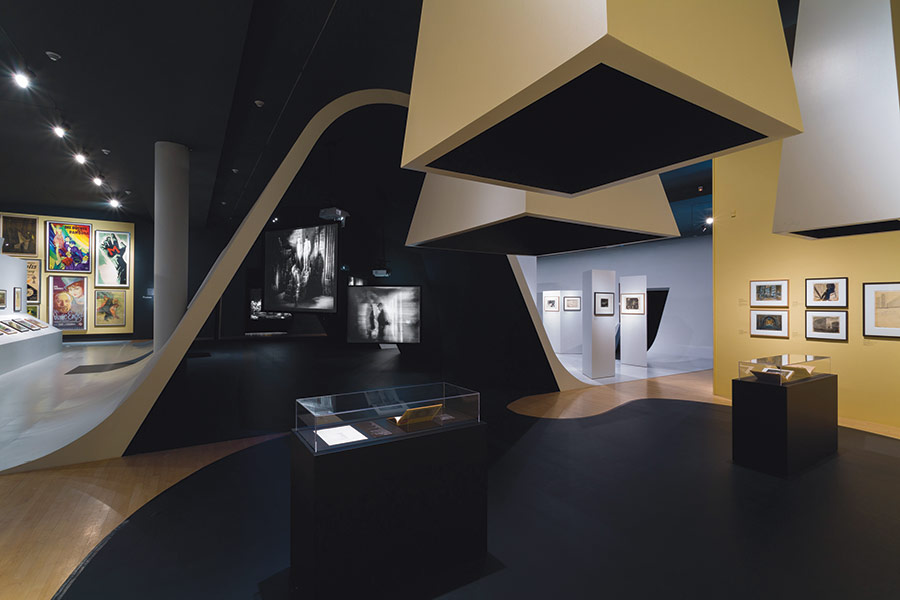
Haunted Screens: German Cinema in the 1920s
Los Angeles County Museum of Art
5905 Wilshire Boulevard, Los Angeles
Through April 26
Monsters, madmen, and magicians play starring roles in Haunted Screens: German Cinema in the 1920s, an exhibition that runs through April 26 at the Los Angeles County Museum of Art. It’s a worthy successor to LACMA’s many explorations of that fertile era of experimentation. German studios churned out plenty of fluffy entertainments for mass consumption, but they also produced (as Hollywood rarely did) works of art that made few concessions to popular taste. The production sketches, stills, and movie clips from 25 features included in this exhibition reveal the huge potential of film to probe human psychology and imagine worlds that never were. Architects will be drawn to the elaborate sets and city streets, and by the installation, which was designed by Michael Maltzan and Amy Murphy.
The show has a strong emphasis throughout on architecture and urbanism. LACMA curator Britt Salvesen divided the 250 exhibits into four thematic sections and deftly wove them into a visual narrative, elucidated by succinct text panels. Within each section, one can review set and costume designs alongside production stills for a few features, and then step into a darkened space to watch excerpts of those films, back-projected onto suspended screens. Happily there was a rich trove to draw on, principally from the collection of the Cinémathèque Française in Paris. Hollywood studios squandered their treasures, treating talent as hired hands, and junking their archives. Most of their publicity stills were portraits of popular stars; at UFA, the leading German studio, up to 800 photos documented every aspect of a major production. Lotte Eisner and other dedicated archivists rescued prints and drawings that survived wartime devastation and carried them off to the Cinémathèque. In doing so, they preserved a legacy of art and history.
Like the painters and sculptors whom the Nazis would soon condemn as decadent, filmmakers—including Fritz Lang, F.W. Murnau, Georg Pabst, and Robert Wiene—mirrored the turmoil and creativity of the Weimar Republic. The distorted houses, oppressive city streets, and sinister laboratories they constructed on stages and back lots mirrored a society struggling to break free of the past, even as its economy and government foundered. Whereas the best German architecture of the 1920s—from the Weissenhofsiedlung to luxury villas and workers’ housing estates—is cool and rational, filmmakers exposed the contradictions of the times and the dark underside of material progress. Their subjects ranged from grinding poverty in the slums to the polarization of wealth, futuristic fantasies and folklore, surveillance and the threat of new technologies. The demons that haunt these films would soon achieve power: critic Siegfried Kracauer entitled his history of film, From Caligari to Hitler.
To articulate this multi-layered story and heighten its impact, Maltzan and Murphy have constructed a trio of wave-like forms to enclose projection screens, which are set at angles to each other, so one can watch one or several clips simultaneously. In the troughs between, small drawings and production stills are displayed on the canted surfaces, shard-like columns, and a jagged, open-ended frame. Posters occupy the side walls of the gallery, and sound cones descend from the ceiling. The installation is easy to navigate, but it subtly conveys an air of menace, mystery, and insecurity. Within a confined gallery, one can examine the exhibits, absorb the febrile atmosphere of Weimar, and surrender to the timeless magic of the movies.
LACMA is an appropriate host. It frequently presents selections from its fine collection of German Expressionist art, and commissions leading architects (including Frank Gehry, Morphosis, and Frederick Fisher) to install exhibitions. And it is located in the city that lured the finest talents of Germany in the years between the two world wars. Writers, directors, producers, actors, and—most successfully—cinematographers and composers migrated to Hollywood, initially for the money, and later as refugees. They brought a new sophistication to an escapist industry, and they helped establish the genre of film noir. For a decade, LA became Weimar on the Pacific, and there’s a faint echo of that era in the more interesting independent movies of recent years. Haunted Screens takes us back to the source.